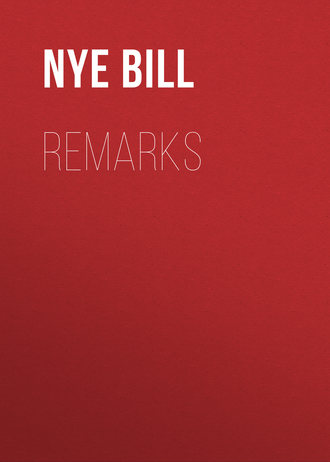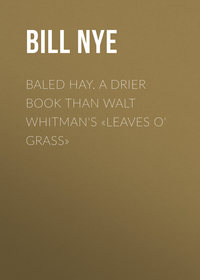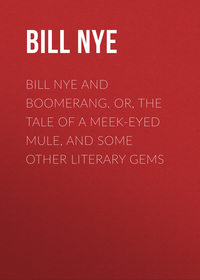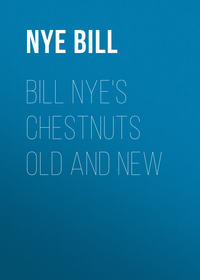 полная версия
полная версияRemarks
Soon after that they discovered that comets all had more or less periodicity. Nobody knows how they got it. All the astronomers had been watching them day and night and didn’t know when they were exposed, but there was no time to talk and argue over the question. There were two or three hundred comets all down with it at once. It was an exciting time.
Comets sometimes live to a great age. This shows that the night air is not so injurious to the health as many people would have us believe. The great comet of 1780 is supposed to have been the one that was noticed about the time of Caesar’s death, 44 B.C., and still, when it appeared in Newton’s time, seventeen hundred years after its first grand farewell tour, Ike said that it was very well preserved, indeed, and seemed to have retained all its faculties in good shape.
Astronomers say that the tails of all comets are turned from the sun. I do not know why they do this, whether it is etiquette among them or just a mere habit.
A later writer on astronomy said that the substance of the nebulosity and the tail is of almost inconceivable tenuity. He said this and then death came to his relief. Another writer says of the comet and its tail that “the curvature of the latter and the acceleration of the periodic time in the case of Encke’s comet indicate their being affected by a resisting medium which has never been observed to have the slightest influence on the planetary periods.”
I do not fully agree with the eminent authority, though he may be right. Much fear has been the result of the comet’s appearance ever since the world began, and it is as good a thing to worry about as anything I know of. If we could get close to a comet without frightening it away, we would find that we could walk through it anywhere as we could through the glare of a torchlight procession. We should so live that we will not be ashamed to look a comet in the eye, however. Let us pay up our newspaper subscription and lead such lives that when the comet strikes we will be ready.
Some worry a good deal about the chances for a big comet to plow into the sun some dark, rainy night, and thus bust up the whole universe. I wish that was all I had to worry about. If any respectable man will agree to pay my taxes and funeral expenses, I will agree to do his worrying about the comet’s crashing into the bosom of the sun and knocking its daylights out.
THE SUN.
This luminous body is 92,000,000 miles from the earth, though there have been mornings this winter when it seemed to me that it was further than that. A railway train going at the rate of 40 miles per hour would be 263 years going there, to say nothing of stopping for fuel or water, or stopping on side tracks to wait for freight trains to pass. Several years ago it was discovered that a slight error had been made in the calculations of the sun’s distance from the earth, and, owing to a misplaced logarithm, or something of that kind, a mistake of 3,000,000 miles was made in the result. People cannot be too careful in such matters. Supposing that, on the strength of the information contained in the old time-table, a man should start out with only provisions sufficient to take him 89,000,000 miles and should then find that 3,0000,000 miles still stretched out ahead of him. He would then have to buy fresh figs of the train boy in order to sustain life. Think of buying nice fresh figs on a train that had been en route 250 years!
Imagine a train boy starting out at ten years of age, and perishing at the age of 60 years with only one-fifth of his journey accomplished. Think of five train boys, one after the other, dying of old age on the way, and the train at last pulling slowly into the depot with not a living thing on board except the worms in the “nice eating apples!”
The sun cannot be examined through an ordinary telescope with impunity. Only one man every tried that, and he is now wearing a glass eye that cost him $9.
If you examine the sun through an ordinary solar microscope, you discover that it has a curdled or mottled appearance, as though suffering from biliousness. It is also marked here and there by long streaks of light, called faculae, which look like foam flecks below a cataract. The spots on the sun vary from minute pores the size of an ordinary school district to spots 100,000 miles in diameter, visible to the nude eye. The center of these spots is as black as a brunette cat, and is called the umbra, so called because it resembles an umbrella. The next circle is less dark, and called the penumbra, because it so closely resembles the penumbra.
There are many theories regarding these spots, but, to be perfectly candid with the gentle reader, neither Prof. Proctor nor myself can tell exactly what they are. If we could get a little closer, we flatter ourselves that we could speak more definitely. My own theory is they are either, first, open air caucuses held by the colored people of the sun; or, second, they may be the dark horses in the campaign; or, third, they may be the spots knocked off the defeated candidate by the opposition.
Frankly, however, I do not believe either of these theories to be tenable. Prof. Proctor sneers at these theories also on the ground that these spots do not appear to revolve so fast as the sun. This, however, I am prepared to explain upon the theory that this might be the result of delays in the returns However, I am free to confess that speculative science is filled with the intangible.
The sun revolves upon his or her axletree, as the case may be, once in 25 to 28 of our days, so that a man living there would have almost two years to pay a 30-day note. We should so live that when we come to die we may go at once to the sun.
Regarding the sun’s temperature, Sir John Herschel says that it is sufficient to melt a shell of ice covering its entire surface to a depth of 40 feet. I do not know whether he made this experiment personally or hired a man to do it for him.
The sun is like the star spangled banner—as it is “still there.” You get up to-morrow morning just before sunrise and look away toward the east, and keep on looking in that direction, and at last you will see a fine sight, if what I have been told is true. If the sunrise is as grand as the sunset, it indeed must be one of nature’s most sublime phenomena.
The sun is the great source of light and heat for our earth. If the sun were to go somewhere for a few weeks for relaxation and rest, it would be a cold day for us. The moon, too, would be useless, for she is largely dependent on the sun. Animal life would soon cease and real estate would become depressed in price. We owe very much of our enjoyment to the sun, and not many years ago there were a large number of people who worshiped the sun. When a man showed signs of emotional insanity, they took him up on the observatory of the temple and sacrificed him to the sun. They were a very prosperous and happy people. If the conqueror had not come among them with civilization and guns and grand juries they would have been very happy, indeed.
THE STARS.
There is much in the great field of astronomy that is discouraging to the savant who hasn’t the time nor means to rummage around through the heavens. At times I am almost hopeless, and feel like saying to the great yearnful, hungry world: “Grope on forever. Do not ask me for another scientific fact. Find it out yourself. Hunt up your own new-laid planets, and let me have a rest. Never ask me again to sit up all night and take care of a newborn world, while you lie in bed and reck not.”
I get no salary for examining the trackless void night after night when I ought to be in bed. I sacrifice my health in order that the public may know at once of the presence of a red-hot comet, fresh from the factory. And yet, what thanks do I get?
Is it surprising that every little while I contemplate withdrawing from scientific research, to go and skin an eight-mule team down through the dim vista of relentless years?
Then, again, you take a certain style of star, which you learn from Professor Simon Newcomb is such a distance that it takes 50,000 years for its light to reach Boston. Now, we will suppose that after looking over the large stock of new and second-hand stars, and after examining the spring catalogue and price list, I decide that one of the smaller size will do me, and I buy it. How do I know that it was there when I bought it? Its cold and silent rays may have ceased 49,000 years before I was born and the intelligence be still on the way. There is too much margin between sale and delivery. Every now and then another astronomer comes to me and says: “Professor, I have discovered another new star and intend to file it. Found it last night about a mile and a half south of the zenith, running loose. Haven’t heard of anybody who has lost a star of the fifteenth magnitude, about thirteen hands high, with light mane and tail, have you?” Now, how do I know that he has discovered a brand new star? How can I discover whether he is or is not playing an old, threadbare star on me for a new one?
We are told that there has been no perceptible growth or decay in the star business since man began to roam around through space, in his mind, and make figures on the barn door with red chalk showing the celestial time table.
No serious accidents have occurred in the starry heavens since I began to observe and study their habits. Not a star has waxed, not a star has waned to my knowledge. Not a planet has season-cracked or shown any of the injurious effects of our rigorous climate. Not a star has ripened prematurely or fallen off the trees. The varnish on the very oldest stars I find on close and critical examination to be in splendid condition. They will all no doubt wear as long as we need them, and wink on long after we have ceased to wink back.
In 1866 there appeared suddenly in the northern crown a star of about the third magnitude and worth at least $250. It was generally conceded by astronomers that this was a brand new star that had never been used, but upon consulting Argelander’s star catalogue and price list it was found that this was not a new star at all, but an old, faded star of the ninth magnitude, with the front breadths turned wrong side out and trimmed with moonlight along the seams. After a few days of phenomenal brightness, it gently ceased to draw a salary as a star of the third magnitude, and walked home with an Uncle Tom’s Cabin company.
It is such things as this that make the life of the astronomer one of constant and discouraging toil. I have long contemplated, as I say, the advisability of retiring from this field of science and allowing others to light the northern lights, skim the milky way and do other celestial chores. I would do it myself cheerfully if my health would permit, but for years I have realized, and so has my wife, that my duties as an astronomer kept me up too much at night, and my wife is certainly right about it when she says if I insist on scanning the heavens night after night, coming home late with the cork out of my telescope and my eyes red and swollen with these exhausting night vigils, I will be cut down in my prime. So I am liable to abandon the great labor to which I had intended to devote my life, my dazzling genius and my princely income. I hope that other savants will spare me the pain of another refusal, for my mind is fully made up that unless another skimmist is at once secured, the milky way will henceforth remain unskum.
A Thrilling Experience
I had a very thrilling experience the other evening. I had just filled an engagement in a strange city, and retired to my cozy room at the hotel.
The thunders of applause had died away, and the opera house had been locked up to await the arrival of an Uncle Tom’s Cabin Company. The last loiterer had returned to his home, and the lights in the palace of the pork packer were extinguished.
No sound was heard, save the low, tremulous swash of the sleet outside, or the death-rattle in the throat of the bath-tub. Then all was still as the bosom of a fried chicken when the spirit has departed.
The swallow-tail coat hung limp and weary in the wardrobe, and the gross receipts of the evening were under my pillow. I needed sleep, for I was worn out with travel and anxiety, but the fear of being robbed kept me from repose. I know how desperate a man becomes when he yearns for another’s gold. I know how cupidity drives a wicked man to mangle his victim, that he may win precarious prosperity, and how he will often take a short cut to wealth by means of murder, when, if he would enter politics, he might accomplish his purpose as surely and much more safely.
Anon, however, tired nature succumbed. I know I had succumbed, for the bell-boy afterward testified that he heard me do so.
The gentle warmth of the steam-heated room, and the comforting assurance of duty well done and the approval of friends, at last lulled me into a gentle repose.
Anyone who might have looked upon me, as I lay there in that innocent slumber, with the winsome mouth slightly ajar and the playful limbs cast wildly about, while a merry smile now and then flitted across the regular features, would have said that no heart could be so hard as to harbor ill for one so guileless and so simple.
I do not know what it was that caused me to wake. Some slight sound or other, no doubt, broke my slumber, and I opened my eyes wildly. The room was in semi-darkness.
Hark!
A slight movement in the corner, and the low, regular breathing of a human being! I was now wide awake. Possibly I could have opened my eyes wider, but not without spilling them out of their sockets.
Regularly came that soft, low breathing. Each time it seemed like a sigh of relief, but it did not relieve me. Evidently it was not done for that purpose. It sounded like a sigh of blessed relief, such as a woman might heave after she has returned from church and transferred herself from the embrace of her new Russia iron, black silk dress into a friendly wrapper.
Regularly, like the rise and fall of a wave on the summer sea, it rose and fell, while my pale lambrequin of hair rose and fell fitfully with it.
I know that people who read this will laugh at it, but there was nothing to laugh at. At first I feared that the sigh might be that of a woman who had entered the room through a transom in order to see me, as I lay wrapt in slumber, and then carry the picture away to gladden her whole life.
But no. That was hardly possible. It was cupidity that had driven some cruel villain to enter my apartments and to crouch in the gloom till the proper moment should come in which to spring upon me, throttle me, crowd a hotel pillow into each lung, and, while I did the Desdemona act, rob me of my hard-earned wealth.
Regularly still rose the soft breathing, as though the robber might be trying to suppress it. I reached gently under the pillow, and securing the money I put it in the pocket of my robe de nuit. Then, with great care, I pulled out a copy of Smith & Wesson’s great work on “How to Ventilate the Human Form.” I said to myself that I would sell my life as dearly as possible, so that whoever bought it would always regret the trade.
Then I opened the volume at the first chapter and addressed a thirty-eight calibre remark in the direction of the breath in the corner.
When the echoes had died away a sigh of relief welled up from the dark corner. Also another sigh of relief later on.
I then decided to light the gas and fight it out. You have no doubt seen a man scratch a match on the leg of his pantaloons. Perhaps you have also seen an absent-minded man undertake to do so, forgetting that his pantaloons were hanging on a chair at the other end of the room.
However, I lit the gas with my left hand and kept my revolver pointed toward the dark corner where the breath was still rising and falling.
People who had heard my lecture came rushing in, hoping to find that I had suicided, but they found that, instead of humoring the public in that way, I had shot the valve off the steam radiator.
It is humiliating to write the foregoing myself, but I would rather do so than have the affair garbled by careless hands.
Catching a Buffalo
A pleasing anecdote is being told through the press columns recently, of an encounter on the South Platte, which occurred some years ago between a Texan and a buffalo. The recital sets forth the fact that the Texans went out to hunt buffalo, hoping to get enough for a mess during the day. Toward evening they saw two gentlemen buffalo on a neighboring hill near the Platte, and at once pursued their game, each selecting an animal. They separated at once, Jack going one way galloping after his beast, while Sam went in the other direction. Jack soon got a shot at his game, but the bullet only tore a large hole in the fleshy shoulder of the bull and buried itself in the neck, maddening the animal to such a degree that he turned at once and charged upon horse and rider.
The astonished horse, with the wonderful courage, sagacity and sang froid peculiar to the broncho, whirled around two consecutive times, tangled his feet in the tall grass and fell, throwing his rider about fifty feet. He then rose and walked away to a quiet place, where he could consider the matter and give the buffalo an opportunity to recover.
The infuriated bull then gave chase to Jack, who kept out of the way for a few yards only, when, getting his legs entangled in the grass, he fell so suddenly that his pursuer dashed over him without doing him any bodily injury. However, as the animal went over his prostrate form, Jack felt the buffalo’s tail brush across his face, and, rising suddenly, he caught it with a terrific grip and hung to it, thus keeping out of the reach of his enemy’s horns, till his strength was just giving out, when Sam hove in sight and put a large bullet through the bull’s heart.
This tale is told, apparently, by an old plainsman and scout, who reels it off as though he might be telling his own experience.
Now, I do not wish to seem captious and always sticking my nose into what is none of my business, but as a logical and zoological fact, I desire, in my cursory way, to coolly take up the subject of the buffalo tail. Those who have been in the habit of killing buffaloes, instead of running an account at the butcher shop, will remember that this noble animal has a genuine camel’s hair tail about eight inches long, with a chenille tassel at the end, which he throws up into the rarified atmosphere of the far west, whenever he is surprised or agitated.
In passing over a prostrate man, therefore, I apprehend that in order to brush his face with the average buffalo tail, it would be necessary for him to sit down on the bosom of the prostrate scout and fan his features with the miniature caudal bud.
The buffalo does not gallop an hundred miles a day, dragging his tail across the bunch grass and alkali of the boundless plains.
He snorts a little, turns his bloodshot eyes toward the enemy a moment and then, throwing his cunning little taillet over the dash-boardlet, he wings away in an opposite direction.
The man who could lie on his back and grab that vision by the tail would have to be moderately active. If he succeeded, however, it would be a question of the sixteenth part of a second only, whether he had his arms jerked out by the roots and scattered through space or whether he had strength of will sufficient to yank out the withered little frizz and told the quivering ornament in his hands. Few people have the moral courage to follow a buffalo around over half a day holding on by the tail. It is said that a Sioux brave once tried it, and they say his tracks were thirteen miles apart. After merrily sauntering around with the buffalo one hour, during which time he crossed the territories of Wyoming and Dakota twice and surrounded the regular army three times, he became discouraged and died fiom the injuries he had received. Perhaps, however, it may have been fatigue.
It might be possible for a man to catch hold of the meager tail of a meteor and let it snatch him through the coming years.
It might be, that a man with a strong constitution could catch a cyclone and ride it bareback across the United States and then have a fresh one ready to ride back again, but to catch a buffalo bull in the full flush of manhood, as it were, and retain his tail while he crossed three reservations and two mountain ranges, requires great tenacity of purpose and unusual mental equipoise.
Remember, I do not regard the story I refer to as false, at least I do not wish to be so understood. I simply say that it recounts an incident that is rather out of the ordinary. Let the gentle reader lie down and have a Jackrabbit driven across his face, for instance. The J. Rabbit is as likely to brush your face with his brief and erect tail as the buffalo would be. Then carefully note how rapidly and promptly instantaneous you must be. Then closely attend to the manner in which you abruptly and almost simultaneously, have not retained the tail in your memory.
A few people may have successfully seized the grieved and startled buffalo by the tail, but they are not here to testify to the circumstances. They are dead, abnormally and extremely dead.
John Adams
After viewing the birthplace of the Adamses out at Quincy I felt more reconciled to my own birthplace. Comparing the house in which I was born with those in which other eminent philanthropists and high-priced statesmen originated, I find that I have no reason to complain. Neither of the Adamses were born in a larger house than I was, and for general tone and eclat of front yard and cook-room on behind, I am led to believe that I have the advantage.
John Adams was born before John Quincy Adams. A popular idea seems to prevail in some sections of the Union that inasmuch as John Q. was bald-headed, he was the eider of the two; but I inquired about that while on the ground where they were both born, and ascertained from people who were familiar with the circumstances, that John was born first.
John Adams was the second president of the United States. He was a lawyer by profession, but his attention was called to politics by the passage of the stamp act in 1765. He was one of the delegates who represented Massachusetts in the first Continental Congress, and about that time he wrote a letter in which he said: “The die is now cast; I have passed the rubicon. Sink or swim, live or die, survive or perish with my country is my unalterable determination.” Some have expressed the opinion that “the rubicon” alluded to by Mr. Adams in this letter was a law which he had succeeded in getting passed; but this is not true. The idea of passing the rubicon first originated with Julius Caesar, a foreigner of some note who flourished a good deal B.C.
In June, 1776, Mr. Adams seconded a resolution, moved by Richard Henry Lee, that the United States “are, and of right ought to be, free and independent.” Whenever Mr. Adams could get a chance to whoop for liberty now and forever, one and inseparable, he invariably did so.
In 1796, Mr. Adams ran for president. In the convention it was nip and tuck between Thomas Jefferson and himself, but Jefferson was understood to be a Universalist, or an Universalist, whichever would look the best in print, and so he only got 68 votes out of a possible 139. In 1800, however, Jefferson turned the tables on him, and Mr. Adams only received 65 to Jefferson’s 73 votes.
Mr. Adams made a good president and earned his salary, though it wasn’t so much of a job as it is now. When there was no Indian war in those days the president could put on an old blue flannel shirt and such other clothes as he might feel disposed to adopt, and fish for bull heads in the Potomac till his nose peeled in the full glare of the fervid sun.
Now it is far different. By the time we get through with a president nowadays he isn’t good for much. Mr. Hayes stood the fatigue of being president better, perhaps, than any other man since the republic became so large a machine. Mr. Hayes went home to Fremont with his mind just as fresh and his brain as cool as when he pulled up his coat tails to sit down in the presidential chair. The reason why Mr. Hayes saved his mind, his brain and his salary, was plain enough when we stop to consider that he did not use them much during his administration.







